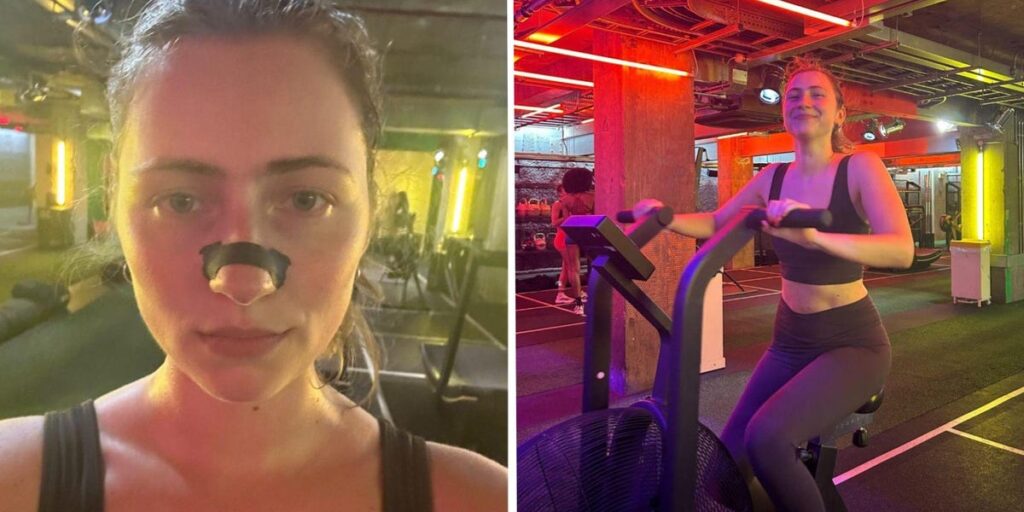I have a strange question, but stay with me: Have you ever thought about how long you can run without breathing through your mouth? In a dark basement in central London I recently discovered that, for me, the answer is: Not for very long.
Apparently, that means my VO2 max, or ability to send oxygenated blood to my muscles, and how well my muscles can use that oxygen during intense exercise, is quite low.
Translation: I’m unfit.
I do low-impact strength training like yoga and pilates most days, but no cardio. I’ve tried to get into running, but it never sticks, and I find cardio machines boring.
I learned specifically how bad I am at cardio at V02:MAXED, a new class at London’s GymBox. I knew one session wouldn’t transform my health, but I was interested to try the first class I’d seen marketed around VO2 max.
I wondered if exercising with a specific goal might motivate me to finally form a cardio habit, and if the class — and the nose strips we had to wear while working out — was just a fad.
Once the preserve of high-level athletes, in recent years, VO2 max has become a buzzy measure of cardiovascular fitness among runners, fitness competition enthusiasts, and health optimization bros. People are obsessed with it because it’s said to be a strong predictor of longevity.
As I’m not an endurance athlete, my low score may not seem like a big deal, but having a high VO2 max is linked to a longer life, and a reduced risk of conditions including cardiovascular disease, cancer, and diabetes.
I don’t care that I can’t run five kilometers in under 30 minutes, but I do care about staying active and healthy as I age.
To increase your VO2 max, you have to do a mixture of shorter high-intensity and longer, easier workouts. VO2:Maxed is a 16-week course where clients train at a range of intensities. The class I did was the fourth in the series.
Feeling nervous about entering a gym that uses the words “gnarly,” “sadistic,” and “savage” to describe some of its classes, I descended the staircase from the reception area to the dimly lit bodybuilder’s playground below with trepidation.
We had to breathe through our noses for as long as possible
In the 50-minute class, we repeated three-minute sets on a stroke machine (ski or rower) and a cycle machine (bike or treadmill), with 45-second breaks in between. I used a ski machine and an assault bike.
What made the class unique was the breathwork. Our instructor, Firas Iskandarani, a Hyrox and Crossfit coach, explained that we should aim to breathe through our noses for most of the class. He called this type of breathing “gear one,” and breathing in through the nose and out through the mouth “gear two.”
We were told to note when we had to “switch gears.” Iskandarani said this should happen after around 90-seconds to two-minutes, but I struggled to get to one minute.
As a rough guide, the longer you can stay in gear one, the higher your VO2 max is likely to be, he said. The idea is that, over time, you will need to switch gears less quickly, which indicates your aerobic capacity has increased.
About halfway through the class, we were given nasal strips to stick on the fleshy part of our noses, and encouraged to notice if it helped us stay in gear one for longer.
It’s thought that widening the nasal canal could help to increase endurance by allowing more air through the nose. But one 2020 meta-analysis published in the European Archives of Oto-Rhino-Laryngology found that wearing a nasal strip while exercising didn’t improve VO2 Max or heart rate. Still, lots of runners and athletes swear by them, like the elite tennis player Carlos Alcaraz, who wears them during his matches.
I felt that the nasal strip helped a little, but it kept peeling off as my nose got sweaty.
Breathing through your nose while exercising is thought to help you stay in Zone 2
Nasal breathing is not directly linked to improving VO2 max, but is thought to help the body use oxygen more efficiently.
It also encourages you to stay in Zone 2, or at 60-70% of your maximum heart rate, while you’re exercising. Your muscles have more access to oxygen in Zone 2, making it an effective way to increase aerobic endurance.
Once you enter Zone 3, 70% to 80% of your max heart rate, you’re moving at an intensity that’s too much for the available oxygen supply, which causes you to get out of breath.
Breathing through my nose and doing cardio at the same time was hard
I found there was a lot to remember and focus on in this class: not only understanding the different gears, but trying to stay in gear one while checking the clock to see when I started mouth breathing.
All of this mental arithmetic was required on top of the three-minute sets of cardio, which, I think is fair to say, is a long time. My mind kept wandering and I kept accidentally mouth breathing before I’d actually reached my threshold.
It was also tricky to go at a slow enough pace to stay in gear one for even a minute. After about thirty seconds I started to lose my breath. I suppose that tells me I have some work to do in this area.
That being said, I wasn’t huffing and puffing or red in the face afterwards like I usually am after a 35-minute run. But my arms did get very tired from pulling the ropes on the ski machine and moving the handles on the assault bike back and forth.
A structured class made working on my cardio feel more achievable
If I did this class again I would pace myself better so that I wouldn’t get out of breath so quickly. But I think for a cardio beginner like me, it was a little too technical and advanced.
Iskandarani said that part of the demand for the class came from Hyrox fans and CrossFitters, who are already pretty fit and looking to increase their endurance for competitions.
But I found doing cardio in such a structured way and with a group of people much more fun and motivating than doing it alone. Going forward, I think I’ll stick to cardio classes rather than running every once in a while, getting bored, and trying again when enough time has passed for me to forget how arduous I found it.
By focusing on my breath, it became apparent that my cardiovascular fitness is lower than I’d like, and I’m only 28. I wondered how it would inevitably deteriorate over time, and if I’m struggling to get through a class like this now, it’s only going to get harder when I’m in my 50s, let alone 80s.
As for the VO2 max workout, I don’t think it was the right cardio class for me, but it’s motivated me to continue my search. Anyone for Zumba?
Read the full article here
















